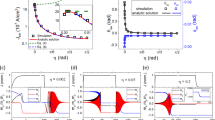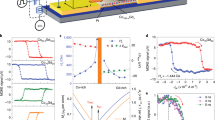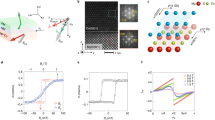Abstract
Spin–orbit torque magnetization switching is an efficient method to control magnetization. In perpendicularly magnetized films, two types of spin–orbit torque are induced by driving a current: a damping-like torque and a field-like torque. The damping-like torque assists magnetization switching, but a large field-like torque pushes the magnetization towards the in-plane direction, resulting in a larger critical switching current density and making deterministic switching challenging. Control of the field-like torque strength is difficult because it is intrinsic to the material system used. Here, we show that the field-like term can be suppressed in a spin–orbit ferromagnetic single layer of (Ga,Mn)As by a current-induced Oersted field due to its non-uniform current distribution, making the damping-like torque term (the result of strong Dresselhaus spin–orbit coupling) dominant. The Oersted field can be controlled by the film thickness, resulting in an extremely low switching current density of 4.6 × 104 A cm–2. This strategy can thus provide an efficient approach to spin–orbit torque magnetization switching.
This is a preview of subscription content, access via your institution
Access options
Access Nature and 54 other Nature Portfolio journals
Get Nature+, our best-value online-access subscription
$29.99 / 30 days
cancel any time
Subscribe to this journal
Receive 12 digital issues and online access to articles
$119.00 per year
only $9.92 per issue
Buy this article
- Purchase on Springer Link
- Instant access to full article PDF
Prices may be subject to local taxes which are calculated during checkout





Similar content being viewed by others
Data availability
The data that support the plots within this paper and other findings of this study are available at https://doi.org/10.6084/m9.figshare.12961430.v1. Source data are provided with this paper.
References
Liu, L., Lee, O. J., Gudmundsen, T. J., Ralph, D. C. & Buhrman, R. A. Current-induced switching of perpendicularly magnetized magnetic layers using spin torque from the spin Hall effect. Phys. Rev. Lett. 109, 096602 (2012).
Shi, G. Y. et al. Spin-orbit torque in MgO/CoFeB/Ta/CoFeB/MgO symmetric structure with interlayer antiferromagnetic coupling. Phys. Rev. B 95, 104435 (2017).
Liu, L. et al. Spin-torque switching with the giant spin Hall effect of tantalum. Science 336, 555–558 (2012).
Miron, I. M. et al. Perpendicular switching of a single ferromagnetic layer induced by in-plane current injection. Nature 476, 189–193 (2011).
Emori, S., Bauer, U., Ahn, S. M., Martinez, E. & Beach, G. S. D. Current-driven dynamics of chiral ferromagnetic domain walls. Nat. Mater. 12, 611–616 (2013).
Myers, E. B., Ralph, D. C., Katine, J. A., Louie, R. N. & Buhrman, R. A. Current-induced switching of domains in magnetic multilayer devices. Science 285, 867–870 (1999).
An, H., Kageyama, Y., Kanno, Y., Enishi, N. & Ando, K. Spin–torque generator engineered by natural oxidation of Cu. Nat. Commun. 7, 13069 (2016).
Jiang, M. et al. Efficient full spin–orbit torque switching in a single layer of a perpendicularly magnetized single-crystalline ferromagnet. Nat. Commun. 10, 2590 (2019).
Khang, N. H. D., Ueda, Y. & Hai, P. N. A conductive topological insulator with large spin Hall effect for ultralow power spin–orbit torque switching. Nat. Mater. 17, 808–813 (2018).
Hai, P. N., Nguyen, H. D. K., Yao, K. & Ueda, Y. Conductive BiSb topological insulator with colossal spin Hall effect for ultra-low power spin-orbit-torque switching. Proc. SPIE 10732, 107320U (2018).
Han, J. et al. Room-temperature spin-orbit torque switching induced by a topological insulator. Phys. Rev. Lett. 119, 077702 (2017).
Fan, Y. et al. Magnetization switching through giant spin–orbit torque in a magnetically doped topological insulator heterostructure. Nat. Mater. 13, 699–704 (2014).
Chernyshov, A. et al. Evidence for reversible control of magnetization in a ferromagnetic material by means of spin–orbit magnetic field. Nat. Phys. 5, 656–659 (2009).
Kurebayashi, H. et al. An antidamping spin–orbit torque originating from the Berry curvature. Nat. Nanotechnol. 9, 211–217 (2014).
Fang, D. et al. Spin–orbit-driven ferromagnetic resonance. Nat. Nanotechnol. 6, 413–417 (2011).
Ohya, S., Takata, K. & Tanaka, M. Nearly non-magnetic valence band of the ferromagnetic semiconductor GaMnAs. Nat. Phys. 7, 342–347 (2011).
Endo, M., Matsukura, F. & Ohno, H. Current induced effective magnetic field and magnetization reversal in uniaxial anisotropy (Ga,Mn)As. Appl. Phys. Lett. 97, 222501 (2010).
Lee, S. et al. Field-free manipulation of magnetization alignments in a Fe/GaAs/GaMnAs multilayer by spin-orbit-induced magnetic fields. Sci. Rep. 7, 10162 (2017).
Kobayashi, M. et al. Unveiling the impurity band induced ferromagnetism in the magnetic semiconductor (Ga,Mn)As. Phys. Rev. B 89, 205204 (2014).
Muneta, I., Ohya, S., Terada, H. & Tanaka, M. Sudden restoration of the band ordering associated with the ferromagnetic phase transition in a semiconductor. Nat. Commun. 7, 12013 (2016).
Muneta, I., Kanaki, T., Ohya, S. & Tanaka, M. Artificial control of the bias-voltage dependence of tunnelling-anisotropic magnetoresistance using quantization in a single-crystal ferromagnet. Nat. Commun. 8, 15387 (2017).
Campion, R. P. et al. The growth of GaMnAs films by molecular beam epitaxy using arsenic dimers. J. Cryst. Growth 251, 311–316 (2003).
Mathieu, R. et al. Magnetization of ultrathin (Ga,Mn)As layers. Phys. Rev. B 68, 184421 (2003).
Luo, J. et al. Uniform annealing effect of electron irradiation on ferromagnetic GaMnAs thin films. J. Magn. Magn. Mater. 422, 124–127 (2017).
Nagaosa, N., Sinova, J., Onoda, S., MacDonald, A. H. & Ong, N. P. Anomalous Hall effect. Rev. Mod. Phys. 82, 1539–1592 (2010).
Shi, G. et al. Spin–orbit torque switching in MgO/CoFeB/Ta/CoFeB/MgO heterostructures with a critical current density of 105 A/cm2. Jpn. J. Appl. Phys. 56, 100303 (2017).
Acknowledgements
This work was partly supported by Grants-in-Aid for Scientific Research (no. 16H02095 and no. 18H03860), the CREST program of the Japan Science and Technology Agency (JPMJCR1777), the Spintronics Research Network of Japan (Spin-RNJ) and the China Scholarship Council (no. 201706210086).
Author information
Authors and Affiliations
Contributions
Sample preparation: M.J. and H.A.; measurements: M.J.; data analysis: M.J. and S.S.; writing and project planning: M.J., S.O. and M.T.
Corresponding authors
Ethics declarations
Competing interests
The authors declare no competing interests.
Additional information
Publisher’s note Springer Nature remains neutral with regard to jurisdictional claims in published maps and institutional affiliations.
Supplementary information
Supplementary Information
Supplementary Figs. 1–8, Discussion and Table 1.
Supplementary Data
Statistical source data for Supplementary Fig. 2.
Supplementary Data
Statistical source data for Supplementary Fig. 3.
Supplementary Data
Statistical source data for Supplementary Fig. 4.
Supplementary Data
Statistical source data for Supplementary Fig. 5.
Supplementary Data
Statistical source data for Supplementary Fig. 6.
Supplementary Data
Statistical source data for Supplementary Fig. 7.
Supplementary Data
Statistical source data for Supplementary Fig. 8.
Source data
Source Data Fig. 2
Statistical source data.
Source Data Fig. 3
Statistical source data.
Source Data Fig. 4
Statistical source data.
Source Data Fig. 5
Statistical source data.
Rights and permissions
About this article
Cite this article
Jiang, M., Asahara, H., Sato, S. et al. Suppression of the field-like torque for efficient magnetization switching in a spin–orbit ferromagnet. Nat Electron 3, 751–756 (2020). https://doi.org/10.1038/s41928-020-00500-w
Received:
Accepted:
Published:
Issue Date:
DOI: https://doi.org/10.1038/s41928-020-00500-w
This article is cited by
-
Room-temperature electrically switchable spin–valley coupling in a van der Waals ferroelectric halide perovskite with persistent spin helix
Nature Photonics (2022)
-
Mechanism of field-like torque in spin-orbit torque switching of perpendicular magnetic tunnel junction
Science China Physics, Mechanics & Astronomy (2022)



